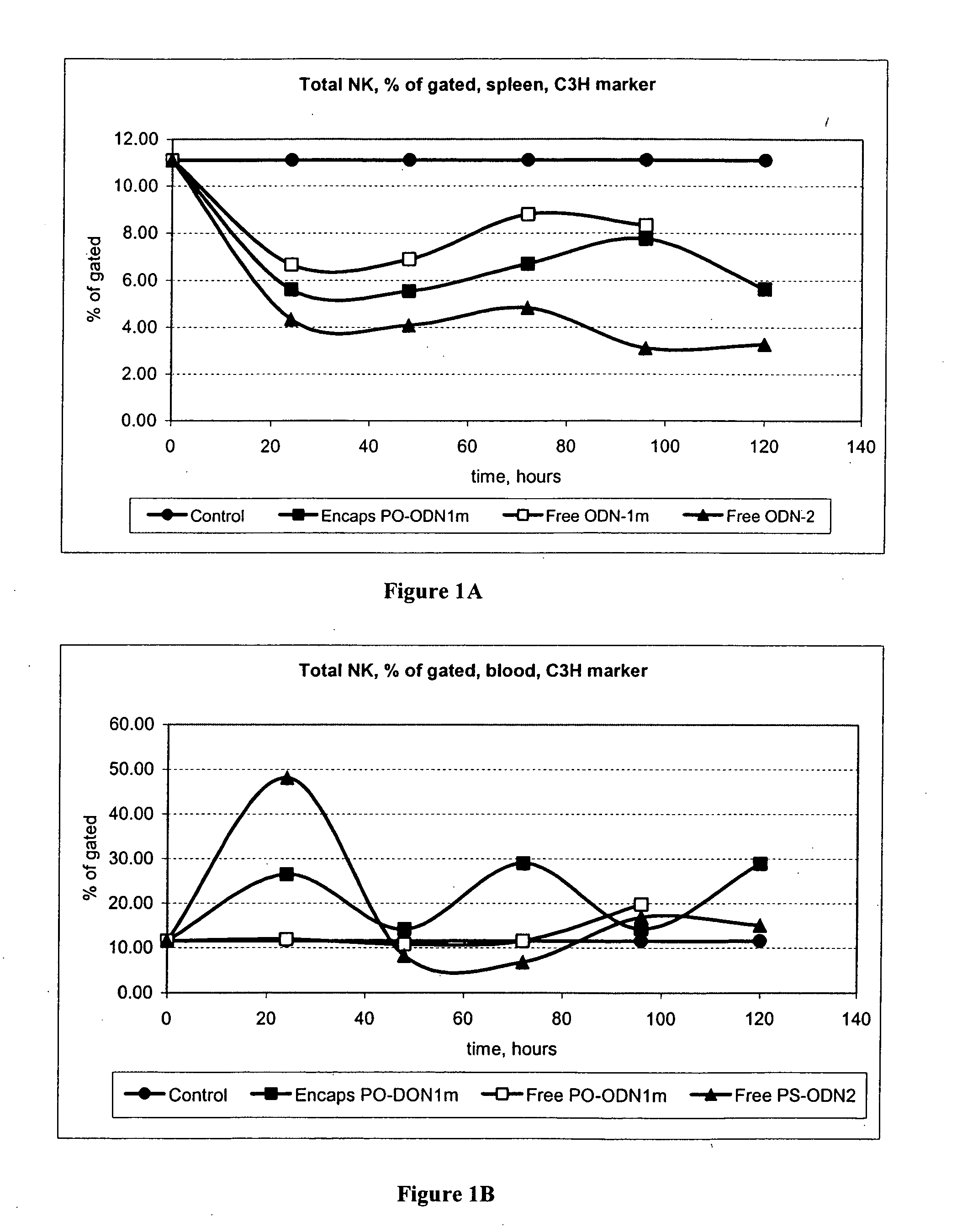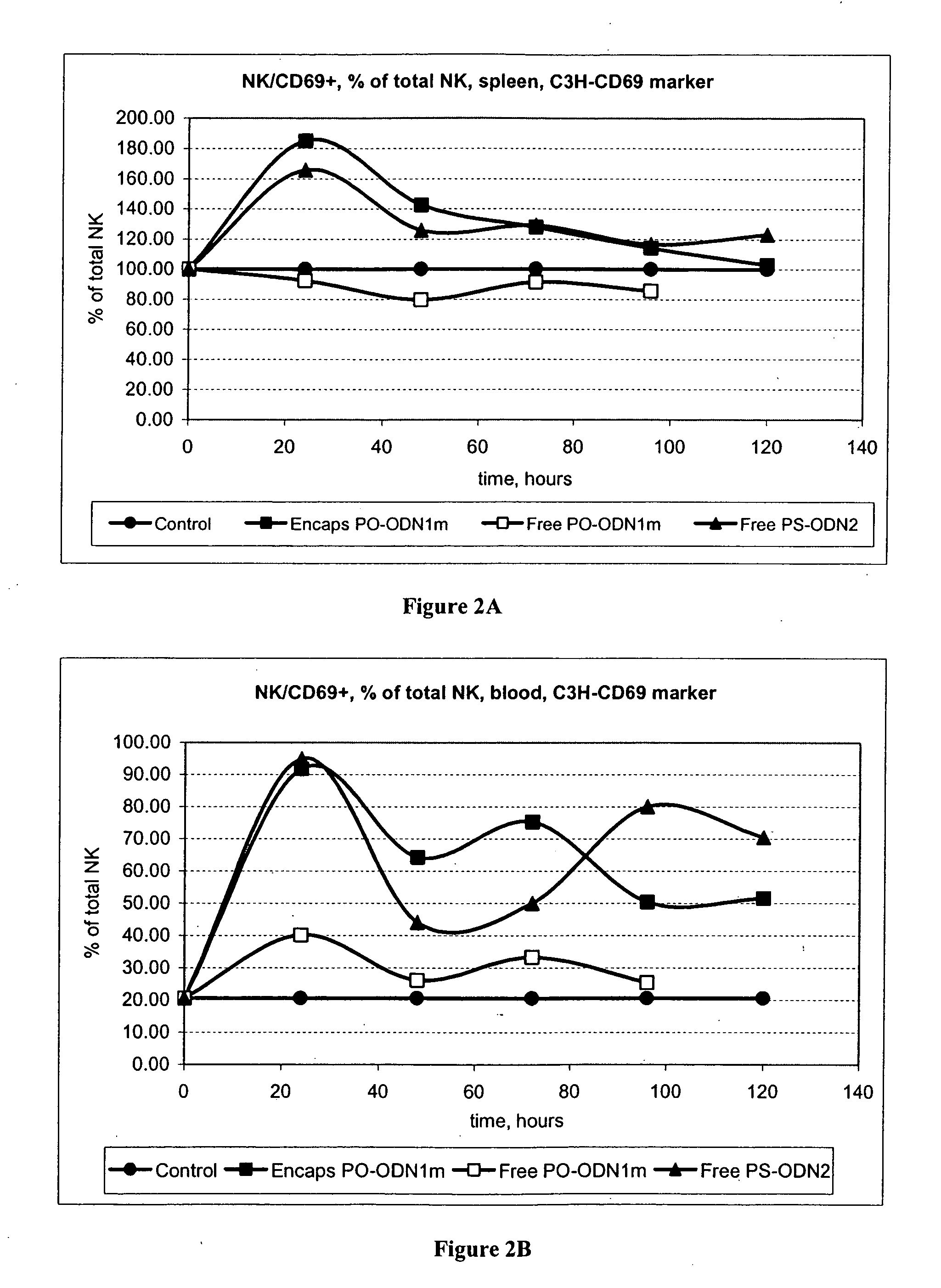Methods and compositions for enhancing innate immunity and antibody dependent cellular cytotoxicity
a technology of innate immunity and cytotoxicity, applied in the field of antibody therapeutics, can solve the problems of limited potency and insufficient data to support broad assertions of activity of antibody therapeutics, and achieve the effects of improving the effect of antibody therapeutics in effectuating lysis of target cells, enhancing the innate immune response, and strong synergistic improvement of target cell lysis
- Summary
- Abstract
- Description
- Claims
- Application Information
AI Technical Summary
Benefits of technology
Problems solved by technology
Method used
Image
Examples
example 1
[0174] This series of experiments was designed to investigate the ability of cationic liposomes comprising an immunostimulatory nucleic acid to mediate ADCC and activate NK and LAK.
Materials and Methods
[0175] Mice. In this experiment, 60 C3H female mice, 8-9 weeks old (22-25 g) by the time of th experiment were used. The animals were housed in groups of four.
[0176] Dosages. There were three treatment groups plus a control, 5 time points. Administrations of test samples and controls were via intravenous tail vein injections with injection volume dependent on body weight (e.g., 200 ml for a 20 g mouse, 350 ml for a 25 g mouse, etc.). Animals will receive 20 mg ODN / kg dose of ODN 2 [SEQ ID NO:1] PS free or ODN 1m [SEQ ID NO:4] free or cationic liposome comprising ODN 1m [SEQ ID NO:4] per injection; at 2 mg / ml in PBS.
[0177] Harvest. Mice spleen and blood were harvested (no sterile conditions required). Tissues were dissociated and cells collected for in vitro analysis.
[0178] Data ...
example 2
[0182] This series of experiments was designed to investigate the ability of cationic liposomes comprising an immunostimulatory nucleic acid to mediate ADCC and activate NK and LAK.
[0183] Mice. 40 C3H female mice, 6-8 weeks old (20-22 g) by the time of the experiment. The animals were housed in groups of 3 and 4.
[0184] Dosages. Two treatment groups plus a control, at 5 time points. Administrations of test samples and controls were via intravenous tail vein injections with injection volume dependent on body weight (e.g., 200 ml for a 20 g mouse, 350 ml for a 25 g mouse, etc.). Animals will receive 20 mg ODN / kg dose of cationic liposomes comprising ODN 1m [SEQ ID NO:4] prepared at 2 mg / ml in PBS.
[0185] Harvest. Mice blood, liver, lymph node, and spleen were harvested under sterile conditions. Tissues were dissociated and cells collected for in vitro analysis.
[0186] Formulations. Cationic liposomes were made using the pre-formed vesicle (PFV) technique, and utilized EtOH. The refor...
example 3
[0193] This series of experiments was designed to evaluate NK and LAK activity and ability to mediate ADCC in tumour-free and tumour-bearing mice.
[0194] Mice. In this experiment, 20 C57BI / 6J female mice at 8-9 weeks old (20-22 g) were used. The animals were housed in groups of 5.
[0195] Dosages. There were 4 treatment groups. In two of the groups, each mouse received 105 B16 / BL6 cells in 200 ml PBS (IV). 10 days later mice from tumour-free and tumour-bearing treatment groups received an intravenous (i.v.) tail vein injection of cationic liposomes comprising ODN 1m [SEQ ID NO:4]; volume based upon body weight (200 ml for a 20 g mouse, 250 ml for a 25 g mouse, etc). Animals received 20 ODN / kg dose of cationic liposomes comprising ODN 1m [SEQ ID NO:4] per injection; formulation was prepared at 2 mg / ml in HBS.
[0196] Harvest. Animals were terminated 48 hours later and organs (spleen, blood, and lung) harvested (sterile conditions not required). Sterile conditions were not required. Tis...
PUM
| Property | Measurement | Unit |
|---|---|---|
| compositions | aaaaa | aaaaa |
| HPLC | aaaaa | aaaaa |
| elongation factor | aaaaa | aaaaa |
Abstract
Description
Claims
Application Information
 Login to View More
Login to View More - R&D
- Intellectual Property
- Life Sciences
- Materials
- Tech Scout
- Unparalleled Data Quality
- Higher Quality Content
- 60% Fewer Hallucinations
Browse by: Latest US Patents, China's latest patents, Technical Efficacy Thesaurus, Application Domain, Technology Topic, Popular Technical Reports.
© 2025 PatSnap. All rights reserved.Legal|Privacy policy|Modern Slavery Act Transparency Statement|Sitemap|About US| Contact US: help@patsnap.com



